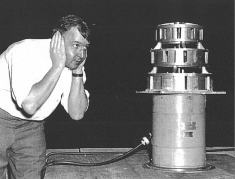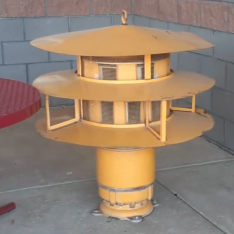Sirex
| Harry O. Ricci Sirex (Si-Rex) | |
 A 10-port Sirex, located in Arbyrd, MO. It is one of the few remaining active Sirex units, and is one of the last surviving 10-port units. Image by Sweet Tea Sirens. | |
| Company | Harry O. Ricci Siren & Signal, Inc. |
|---|---|
| Produced | 1942?-1968? |
| Type | Omnidirectional Electromechanical |
| Sound output | - |
| Horsepower | 10 |
| Preceded by | H.O.R. Siro-Drone |
The Sirex (sometimes referred to as the Si-Rex) is a vertical, omnidirectional siren that was produced by Harry O. Ricci Siren & Signal, Inc. during WWII and the early-mid Cold War, and was a middle ground between the rotational Super Sirex and the smaller vertical Siro-Drones.
History and Design

The Sirex was introduced as early as February 1942, being introduced as a step up from the Siro-Drone, and all units were hand-built by Harry O. Ricci and his company. The Sirex is essentially what would become a Super Sirex in vertical, omnidirectional form, using the exact same rotors and stators as the Super Sirex. All Sirex units use three-phase, 10 hp AC motors, which are located directly under the rotor and stator. The motor has no protection at all from the elements, and there are four mounting holes on the bottom of the motor where the siren can be directly bolted to a mount. This also serves as a stand.

Each Sirex unit uses three louvres that are crudely attached to the rotor and stator, two of which are used to help project the sound from the rotors, while the top louvre serves as a rainshield to protect the rotor from the elements. Four steel reinforcing rods help keep the bottom two louvres in place, while the top louvre is held up by four supports attached to the top of the stator. Mesh screens protect both the rotor and stator, as well as the intakes, from debris. The earliest units built in the 1940s used steep, rounded louvres instead of the wide, flat louvres of later models. These early models used three rotors/stators of different sizes attached to a single shaft, and were a rare example of a tri-tone siren.
The Sirex was available in three port configurations, all using the same rotor/stators as the Super Sirex. Single tone models were available in either 9 or 10-port single tone, using a single rotor and stator. The Sirex was also available in 7/10 port dual tone, using two different rotors and stators, both driven by the single motor on a common shaft. The 7-port rotor and stator are located above the 10-port rotor and stator, held up by 4 support struts. The 7-port rotor and stator are shorter in height than the 10-port.
The vast majority of units were sold in Arizona and New York, where they were a common choice for civil defense use alongside H.O.R.'s other options. These sirens would later be decommissioned and either sold off to other towns, scrapped, or obtained by private owners. The Sirex saw little success elsewhere, as it was more expensive than the Siro-Drone while not performing as well as the Super Sirex. The Sirex would be discontinued in the 1960s alongside all of H.O.R.'s other sirens. Today, few units are still around, with only a single 10-port unit left in service in Arbyrd, MO. Two 7/10 port units with custom housings are in service in Massapequa, NY, with a third 7/10 unit being converted from a former Super Sirex. The rest are in private possession, all of which are 7/10-port dual tone. The majority of these came from Phoenix, AZ's former siren system.